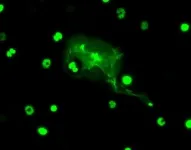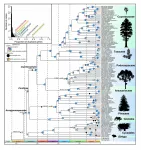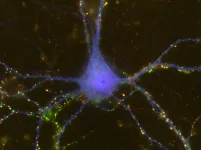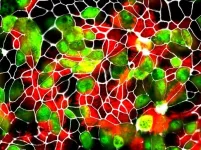Researchers discover how cancer cells that spread to lymph nodes avoid immune destruction
Blood pressure drug losartan may help thwart this evasion tactic.
2021-07-19
(Press-News.org) BOSTON - Lymph nodes are critical to the body's immune response against tumors but paradoxically, cancer cells that spread, or metastasize, to lymph nodes can often avoid being eliminated by immune cells. Recent experiments by investigators at Massachusetts General Hospital (MGH) and Boston University School of Medicine provide insights on the details behind this immune evasion, which could help scientists develop strategies to overcome it. The findings are published in Nature Biomedical Engineering.
"We know that lymph nodes are often the first place cancer spreads as it progresses. We also know that our immune system can attack and kill cancer cells," explains senior and co-corresponding author Timothy P. Padera, PhD, an investigator in Radiation Oncology at MGH and a 2021-2026 MGH Research Scholar. "One of the perplexing questions that has been at the core of the recent work in my lab is how can organs that generate our immune responses--lymph nodes--permit cancer cells to survive and take them over instead of attacking them? This was the driving motivation behind this study."
By analyzing patient tissue from breast, colon, and head and neck cancers, combined with animal models of breast cancer lymph node metastases, Padera and his colleagues showed that immune cells called T cells are abundant in metastatic lymph nodes but fail to penetrate tumors that have spread to such nodes. The team measured increased physical forces, known as solid stress, in lymph nodes with metastatic cancer. "We hypothesized that solid stress in lymph node tumors can impair both blood flow and the T cell trafficking capacity of blood vessels in lymph nodes," says lead and co-corresponding author Dennis Jones, PhD, an assistant professor of Pathology & Laboratory Medicine at the Boston University School of Medicine.
The scientists then developed a device to compress lymph nodes in order to simulate the gradual growth of lymph node metastases. When they applied compressive force to lymph nodes, there was a clear link between physical force and disruption of T cell entry into lymph nodes. "Our findings indicate that as cancer cells grow in the lymph node, they reorganize and alter the lymph node, disabling critical functional responses of the immune system," says Padera. "By understanding how cancer cells are disabling lymph node function, we hope to fight back to help the lymph nodes generate anti-cancer immune responses, which will help fight cancer cells everywhere in the body."
Alleviating solid stress with the blood pressure drug losartan boosted the numbers of blood vessels and T cells in lymph node metastases, suggesting that alleviating solid stress is a potential strategy to improve T cell entry into tumors.
"Our work now leads to many important additional questions," says Jones. "Does losartan treatment combined with immunotherapy cause the eradication of metastatic cancer cells in lymph nodes by T cell killing? And further, does this lead to a strong systemic anti-cancer immune response that helps clear the cancer from the entire body?" Jones notes that finding the answers to these questions could lead to new treatment strategies for patients with metastatic cancer.
INFORMATION:
Padera is an associate professor of Radiation Oncology at Harvard Medical School. In addition to Jones and Padera, co-authors include Zixiong Wang, Ivy X. Chen, Sue Zhang, Rohin Banerji, Pin-Ji Lei, Hengbo Zhou, Victoria Xiao, Cecilia Kwong, Jan Willem M. van Wijnbergen, Ethel R. Pereira, Benjamin J. Vakoc, Peigen Huang, and Hadi T. Nia.
This study was supported by the National Institutes of Health, the Massachusetts General Hospital Executive Committee on Research, the Mass General Research Institute Research Scholars Program, and the METAvivor organization.
About the Massachusetts General Hospital
Massachusetts General Hospital, founded in 1811, is the original and largest teaching hospital of Harvard Medical School. The Mass General Research Institute conducts the largest hospital-based research program in the nation, with annual research operations of more than $1 billion and comprises more than 9,500 researchers working across more than 30 institutes, centers and departments. In August 2020, Mass General was named #6 in the U.S. News & World Report list of "America's Best Hospitals."
About Boston University School of Medicine
Originally established in 1848 as the New England Female Medical College, and incorporated into Boston University in 1873, Boston University School of Medicine (BUSM) today is a leading academic medical center with an enrollment of more than 700 medical students and approximately 1,150 students pursuing degrees in graduate medical sciences. BUSM faculty contribute to more than 605 active grants and contracts, with total anticipated awards valued at more than $200 million in amyloidosis, arthritis, cardiovascular disease, cancer, infectious diseases, pulmonary disease and dermatology, among other areas. The School's teaching affiliates include Boston Medical Center, its primary teaching hospital; Boston VA Healthcare System; St. Elizabeth's Medical Center in Brighton, Mass.; Kaiser Permanente in northern California; plus Boston HealthNet, a network of 15 community health centers. For more information, please visit http://www.bumc.bu.edu/busm/
ELSE PRESS RELEASES FROM THIS DATE:
2021-07-19
A new USC study of a common, yet poorly understood type of white blood cell reveals the immune cell's response to pathogens differs greatly by sex and by age.
In this mouse study, males proved much more susceptible to a condition called sepsis than females. However, the scientists also found that the female disease-defense system is hardly perfect; their system changes with age to become nearly as harmful as the males'.
Those are the key findings in a study that appears today in Nature Aging.
The study has important implications for studying disease and cures, especially for sepsis, a condition in which the body's defense ...
2021-07-19
WHAT:
A new study published in JAMA Neurology suggests that certain features that appear on CT scans help predict outcomes following mild traumatic brain injury (TBI). Patterns detected on the scans may help guide follow up treatment as well as improve recruitment and research study design for head injury clinical trials.
Researchers led by Geoffrey Manley, M.D., Ph.D., professor of neurological surgery at the University of California San Francisco, conducted CT scans in 1,935 subjects with mild TBI and followed their outcomes up to 12 months after injury.
This research was part of the Transforming Research and Clinical Knowledge in Traumatic Brain Injury (TRACK-TBI) study, a large research effort funded by the National Institutes of ...
2021-07-19
Michigan State University ecologists led an international research partnership of professional and volunteer scientists to reveal new insights into what's driving the already-dwindling population of eastern monarch butterflies even lower.
Between 2004 and 2018, changing climate at the monarch's spring and summer breeding grounds has had the most significant impact on this declining population. In fact, the effects of climate change have been nearly seven times more significant than other contributors, such as habitat loss. The team published its report July 19 in the journal Nature Ecology & Evolution.
"What we do is develop models to understand why monarchs are declining ...
2021-07-19
Determining the major drivers of species diversification and phenotypic innovation across the Tree of Life is one of the grand challeges in evolutionary biology.
Facilitated by the Germplasm Bank of Wild Species of the Kunming Institute of Botany (KIB) of the Chinese Academy of Sciences (CAS), Prof. YI Tingshuang and Prof. LI Dezhu of KIB led a novel study on gymnosperm diversification with a team of international researchers.
This study provides critical insight on the processes underlying diversification and phenotypic evolution in gymnosperms, with important broader implications for the major drivers of both micro- and macroevolution in plants.
The results were published today online in Nature ...
2021-07-19
HUNTINGTON, W.Va. - During development, brain cells may find different ways to connect with each other based on sex, according to researchers at the Marshall University Joan C. Edwards School of Medicine.
The study, recently published in eNeuro, an open access journal for the Society of Neuroscience, showed a significantly more robust synaptogenic response in male-derived cells compared to female-derived cells when exposed to factors secreted from astrocytes, which are non-neuronal cells found throughout the central nervous system. This difference was driven largely by how neurons responded to thrombospondin-2 (TSP2), a protein with cell adhesion properties that is normally secreted by astrocytes. ...
2021-07-19
Since the beginning of the pandemic, several reports have indicated that SARS-CoV-2 spillover events have occurred from humans to animals, as evidenced by the transmission of the virus between keepers and tigers and lions in the Bronx Zoo in New York. However, to date, the full range of animal species that are susceptible to SARS-CoV-2 infection remains unclear. Typically, such information could be obtained by experimentally infecting a large variety of animal species with SARS-CoV-2 to see if they are susceptible. However, in order to reduce and refine such animal experiments, the researchers at the University of Bern and at the IVI set out to answer this question ...
2021-07-19
A new study published in Accident Analysis & Prevention shows how biometric data can be used to find potentially challenging and dangerous areas of urban infrastructure before a crash occurs. Lead author Megan Ryerson led a team of researchers in the Stuart Weitzman School of Design and the School of Engineering and Applied Science in collecting and analyzing eye-tracking data from cyclists navigating Philadelphia's streets. The team found that individual-based metrics can provide a more proactive approach for designing safer roadways for bicyclists and pedestrians.
Current federal rules for installing safe transportation interventions at an unsafe crossing--such as a crosswalk with a traffic signal--require either a minimum of 90-100 pedestrians crossing this location every hour ...
2021-07-19
COLUMBUS, Ohio - Flavor is the name of the game for scientists who want to optimize food for consumption in ways that improve nutrition or combat obesity.
But there is more to flavor than the substances that meet the mouth. Olfaction, our sense of smell, is a major contributor to how we perceive aromas, especially those related to what we eat.
With hopes to capitalize on the smell factor in flavor development, researchers are exploring how the route an aroma takes to get to the olfactory system, through the nose or the back of the throat, influences our response to the scent in question.
In a new study, when participants were asked to match a known scent such as rose with one of four unknown scents, they did best when the aromas were introduced ...
2021-07-19
Champaign, IL, July 19, 2021 - For dairy cows, the transition period--the time between a cow giving birth and beginning to produce milk--brings the greatest possibility of health problems. The current widespread belief is that the effects of excess nonesterified fatty acids (NEFA) in the bloodstream and the ensuing hyperketonemia during this period, coupled with low levels of available calcium, are largely responsible for disorders such as mastitis, metritis, retained placenta, and poor fertility. Much attention has therefore been devoted to regulating NEFA and calcium levels in transition cows--yet all these efforts have not made the transition period less of a challenge to cows and, hence, to farmers, with approximately ...
2021-07-19
The second dose of a COVID-19 vaccine induces a powerful boost to a part of the immune system that provides broad antiviral protection, according to a study led by investigators at the Stanford University School of Medicine.
The finding strongly supports the view that the second shot should not be skipped.
"Despite their outstanding efficacy, little is known about how exactly RNA vaccines work," said Bali Pulendran, PhD, professor of pathology and of microbiology and immunology. "So we probed the immune response induced by one of them in exquisite detail."
The study, ...
LAST 30 PRESS RELEASES:
[Press-News.org] Researchers discover how cancer cells that spread to lymph nodes avoid immune destruction
Blood pressure drug losartan may help thwart this evasion tactic.



